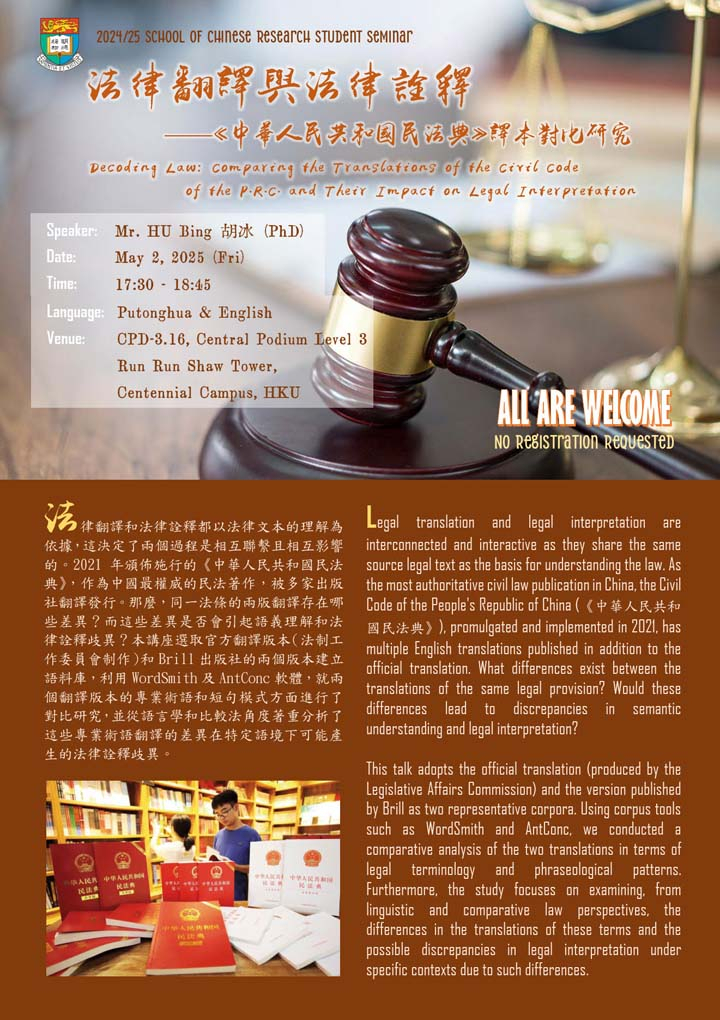法律翻譯與法律詮釋:《中華人民共和國民法典》譯本對比研究 Decoding Law: Comparing the Translations of the Civil Code of the P.R.C. and Their Impact on Legal Interpretation

2024/25 School of Chinese Research Student Seminar
法律翻譯與法律詮釋:《中華人民共和國民法典》譯本對比研究
Decoding Law: Comparing the Translations of the Civil Code of the P.R.C. and Their Impact on Legal Interpretation
Abstract:
法律翻譯和法律詮釋都以法律文本的理解為依據,這決定了兩個過程是相互聯繫且相互影響的。2021年頒佈施行的《中華人民共和國民法典》,作為中國最權威的民法著作,被多家出版社翻譯發行。那麼,同一法條的兩版翻譯存在哪些差異?而這些差異是否會引起語義理解和法律詮釋歧異?
本講座選取官方翻譯版本(法制工作委員會制作)和Brill出版社的兩個版本建立語料庫,利用WordSmith, AntConc軟體,就兩個翻譯版本的專業術語和短句模式方面進行了對比研究,並從語言學和比較法角度著重分析了這些專業術語翻譯的差異在特定語境下可能產生的法律詮釋歧異。
經初步對比,兩版本術語差異基本分為三類:未有語義差別和法律詮釋歧異的術語不統一, 具體法律語境差異引發的術語不統一,以及產生語義差別和法律詮釋歧異的術語不統一。綜合看來,官方翻譯版本更傾向於保持文內術語統一和維護原文本的法律術語詮釋,而Brill出版社版本則更傾向於根據語境對術語進行差異處理,且術語更傾向於借用已有英文法律術語。
Legal translation and legal interpretation are interconnected and interactive as they share the same source legal text as the basis for understanding the law. As the most authoritative civil law publication in China, the Civil Code of the People's Republic of China (《中華人民共和國民法典》), promulgated and implemented in 2021, has multiple English translations published in addition to the official translation. What differences exist between the translations of the same legal provision? Would these differences lead to discrepancies in semantic understanding and legal interpretation?
This talk adopts the official translation (produced by the Legislative Affairs Commission) and the version published by Brill as two representative corpora. Using corpus tools such as WordSmith and AntConc, we conducted a comparative analysis of the two translations in terms of legal terminology and phraseological patterns. Furthermore, the study focuses on examining, from linguistic and comparative law perspectives, the differences in the translations of these terms and the possible discrepancies in legal interpretation under specific contexts due to such differences.
Preliminary comparisons reveal that the differences in terminology of the two translations can be broadly categorized into three types: (1) inconsistencies that would not affect semantic or legal interpretation, (2) inconsistencies arising from variations in legal contexts, and (3) inconsistencies that would lead to semantic differences and variations in legal interpretation. Overall, the official translation tends to prioritize intra-textual consistency of terminology and preserve the legal interpretation of the original Chinese text, while the Brill version demonstrates a greater inclination to adapt terminology based on contextual relevance and more frequently borrows existing English legal terms.








